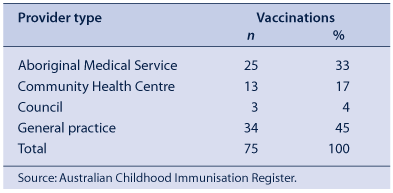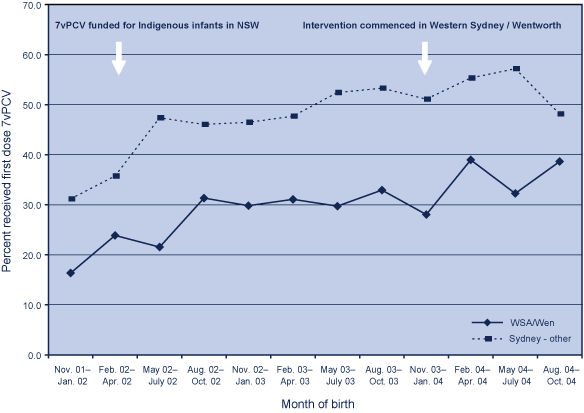Evaluation of a targeted immunisation program for Aboriginal and Torres Strait Islander infants in an urban setting
Paul Thomas A , Telphia L. Joseph B and Robert I. Menzies B CA Centre for Public Health, Sydney West Area Health Service
B National Centre for Immunisation Research and Surveillance of Vaccine Preventable Diseases, The Children’s Hospital at Westmead
C Corresponding author. Email: RobertM3@chw.edu.au
NSW Public Health Bulletin 19(6) 96-99 https://doi.org/10.1071/NB07055
Published: 26 June 2008
Abstract
A conjugate pneumococcal vaccination program for Aboriginal and Torres Strait Islander children in an urban setting initially achieved poor uptake. A targeted intervention was developed to raise awareness among hospital staff, in general practice and in parents of eligible children. An evaluation of the intervention found moderate levels of increased awareness, use of promotional materials and an increase in vaccination. However, significant structural barriers remained.
Background
In February 2002, the 7-valent pneumococcal conjugate vaccine (7vPCV) (Prevenar; Wyeth, Sydney) was provided free in NSW for Aboriginal and Torres Strait Islander infants and others at high risk of invasive pneumococcal disease (IPD) at two, four and six months of age.1 This was a response to higher rates of IPD in Aboriginal and Torres Strait Islander children compared with the total child population.2 (For ease of reporting, henceforth Aboriginal and Torres Strait Islander will be referred to as Aboriginal.)
Based on Australian Bureau of Statistics population statistics, it was estimated that 1200 doses of the vaccination would be required for approximately 400 Aboriginal babies born each year within Western Sydney and Wentworth Area Health Services. However, twelve months after 7vPCV was introduced to the schedule, only 406 vaccine doses had been ordered.
Intervention to improve uptake of 7vPCV
A steering group was convened to identify ways to improve the uptake of 7vPCV among Aboriginal infants in Western Sydney and Wentworth Area Health Services. The group consisted of representatives from the Western Sydney and Wentworth Public Health and Aboriginal Health Units, the Western Sydney Division of General Practice, the National Centre for Immunisation Research and Surveillance of Vaccine Preventable Diseases, and the Daruk Aboriginal Medical Service (AMS).
Coverage rates for vaccines recommended for all children were higher than the state average for Aboriginal children (93% fully vaccinated in Sydney West v. 87% in NSW) and also for non-Aboriginal children (91% v. 90%, respectively).3 The steering group decided that the main reasons for low coverage of 7vPCV in Aboriginal children were likely to be a lack of knowledge about the targeted program among both parents and providers, and failure in identifying eligible infants. An intervention was designed to facilitate the identification of the Indigenous status of babies in maternity hospitals and general practice (GP), and to provide parents of Aboriginal infants with relevant educational materials. These aims were implemented through six actions:
-
maximising the identification of Aboriginal infants by ward staff at the three local maternity hospitals
-
training sessions for all maternity hospital staff, Aboriginal Liaison Officers (ALOs), community health centres and council vaccination staff in the two area health services
-
posters and information sheets were mailed to all local immunisation providers
-
personal contact between parents and ALOs
-
provision of information to parents by ALOs
-
placement of an ‘eligible for free 7vPCV’ sticker in the babies’ Child Health Records (Blue Books) by maternity ward staff.
The sticker was intended to act as a prompt for providers when the child attended hospital for other vaccinations or reasons. An information session was also held at the local GP division meeting, but only a small proportion of GPs attended.
The intervention was fully operational by the last quarter of 2003 and continued until the 7vPCV vaccination was funded for all Australian infants in January 2005.
Evaluation methods
An evaluation was conducted 12 months after the commencement of the intervention to assess:
-
its impact on identifying Aboriginal babies at maternity hospitals
-
the success of sticker placement in Blue Books
-
parents’ and providers’ knowledge about the vaccination program
-
remaining barriers to the identification of Aboriginal babies
-
the contribution of different immunisation service providers to 7vPCV vaccinations.
Interviews
Structured telephone or face-to-face interviews were carried out with all ward-based maternity staff members responsible for placing stickers, ALOs at the two largest hospitals in the area and AMS nursing staff. Structured telephone interviews were also sought from all GPs in the two area health service areas who had ordered 7vPCV during the intervention period.
Nursing staff at Daruk AMS took part in structured interviews. In addition, during a six-week data collection period during May and June 2004, the Child Health Records of all Aboriginal babies born after the commencement of the intervention were checked for the presence of information on 7vPCV and the sticker.
Australian Childhood Immunisation Register data analysis
Analysis was undertaken to determine: the estimated proportion of infants recorded as Aboriginal who had received a first dose of 7vPCV from November 2001 to October 2004; and the distribution of doses administered by provider type (AMS, community health, local council, GP) during the first six months of 2004. Public health units provided vaccine for the intervention program. To obtain distribution data, records of 7vPCV requests to public health units for use in Aboriginal infants born between 1 November 2003 and 30 April 2004 were merged with Australian Childhood Immunisation Register (ACIR) data.
Evaluation results
Interviews
During the intervention, hospital admission departments, previously advised by maternity ward staff and social workers, provided ALOs with the names of Aboriginal babies.
Interviews of staff at maternity hospitals revealed several barriers to identifying babies as Aboriginal; these barriers continued after staff training had taken place. Key barriers were:
-
the reliance on software that recorded the Aboriginal status of mothers, but not of fathers
-
identifying babies discharged after hours, on weekends or after only a short stay; babies of non-resident mothers (such as babies admitted to neonatal intensive care)
-
the difficulty of maintaining staff awareness in this urban setting where few Aboriginal babies were seen
-
the difficulty of maintaining staff awareness among new or relief staff.
Daruk AMS staff reported that their clients were very aware of the 7vPCV vaccine and the need for their babies to receive it.
The extent to which the program was responsible for improving knowledge was uncertain; however, the nursing staff felt it played a substantial role. Nurses also reported that there was now a greater community awareness of the vaccine and that the hospital-based information was supporting this knowledge.
Thirteen babies born after November 2003 were seen during the six weeks that data were collected. Six babies (46%) had the sticker in their Child Health Record, and one had the information postcard in the sleeve of the Child Health Record. Nurses estimated that approximately 60% of all babies who were eligible to receive the 7vPCV vaccination had the sticker in their Child Health Record.
General practice
During the first eight months of the program, 27 of approximately 700 GPs in Western Sydney and Wentworth Area Health Services ordered 7vPCV for an Aboriginal infant born after the intervention commenced. Twenty-three GPs were interviewed; these GPs had vaccinated 29 Aboriginal babies. At GP consultations, Child Health Records were brought for 24 of the babies (83%), seven Child Health Records had a sticker (29%) and, in four consultations (14%), the sticker had contributed to the identification and vaccination of the baby.
Australian Childhood Immunisation Register data analysis
Table 1 presents the results of data on service provider types that reported 7vPCV vaccinations to the Australian Childhood Immunisation Register (ACIR) during the evaluation period. The largest proportion of babies was vaccinated by GPs (45%), followed by the AMS (33%).

|
Figure 1 presents data on the proportion of Aboriginal infants who received the first dose of 7vPCV during the intervention. The Western Sydney and Wentworth Area Health Services had consistently lower coverage compared with other parts of Sydney. This increased in Western Sydney from approximately 30% before the intervention to approximately 40% afterwards, but was still below the 50% vaccination coverage of Aboriginal infants in the rest of Sydney.

|
Discussion
This evaluation has found a moderate impact from an intervention designed to improve the uptake of 7vPCV vaccination of Aboriginal infants in an urban setting. Results suggested a high level of awareness among AMS clients, but only 4% of GPs in the area were known to have vaccinated an Aboriginal infant in the first eight months of the intervention. On follow up, the increased identification of Aboriginal babies and the placement of stickers in Child Health Records were successful for approximately half of Aboriginal infants who attended the AMS.
The methods used in both the intervention and the evaluation were limited by the resources available but were regarded as appropriate.4 Community consultation was limited to the inclusion of the local AMS; only health care workers were interviewed and the evaluation did not include a pre-intervention phase or, with the exception of ACIR coverage data, a comparison group in a non-intervention area. Nevertheless, the results are consistent with previous findings of low uptake of vaccination programs targeted at Aboriginal people, lower vaccination coverage in Aboriginal people in urban areas, low rates of identification of Aboriginal people in NSW hospitals and the considerable difficulties associated with overcoming these issues.5–7
Identification of Indigenous status is fundamental to understanding and addressing equity of access to health care services for Aboriginal people. It is a key objective of both the NSW Aboriginal Health Strategic Plan and the guidelines to improve identification of Indigenous status in the public hospital system.8,9 However, to improve Aboriginal identification and maximise the effectiveness of targeted programs in influencing change, there are system-level barriers that need to be addressed. The implementation of any program targeting Aboriginal people will need to acknowledge and consider the barriers identified in this evaluation.
While the AMS is the largest single provider of immunisation services for Aboriginal babies, this evaluation has shown that for these infants in an urban setting, most will be immunised by a non- Aboriginal provider. Any program in a similar urban setting that targets either Aboriginal immunisation service provision or the needs of immunisation providers should consider the significant role of non- Aboriginal providers. However, most GPs do not immunise Aboriginal babies, and those that do will only immunise small numbers in individual practices. These results have implications for the delivery and use of scarce resources for these immunisation programs in general practice. Future directed programs would need to consider whether (and to whom, and how) to direct resources preferentially. To address this problem it would be helpful to explore the role of divisions of general practice; possible registers of GPs with an interest in Aboriginal health; and the development of formal links between GPs, divisions of general practice and the AMS. More community-based research involving Aboriginal people may uncover other useful strategies.
Conclusion
An intervention developed at the local level has been partially successful in improving the impact of vaccination targeted at Aboriginal children in an urban setting. However, significant structural barriers need to be addressed before equity of access is achieved. These include complete recording of Indigenous status in hospitals and increased awareness in general practice.
[1]
[2] Roche P, Krause V, Andrews R, Carter L, Coleman D, Cook H, et al. Invasive pneumococcal disease in Australia, 2002. Commun Dis Intell 2003; 27 466–77.
| PubMed |

[3] NSW Department of Health Quarterly report: Australian Childhood Immunisation Register. N S W Public Health Bull 2005; 16(11–12): 205–211.
| Crossref | GoogleScholarGoogle Scholar | PubMed |

[4]
[5] Hull BP, McIntyre PB. What do we know about 7vPCV coverage in Aboriginal and Torres Strait Islander children? Commun Dis Intell 2004; 28 238–43.
| PubMed |

[6] Menzies R, McIntyre P, Beard F. Vaccine preventable diseases and vaccination coverage in Aboriginal and Torres Strait Islander people, Australia, 1999 to 2002. Commun Dis Intell 2004; 28

[7]
[8]
[9]

